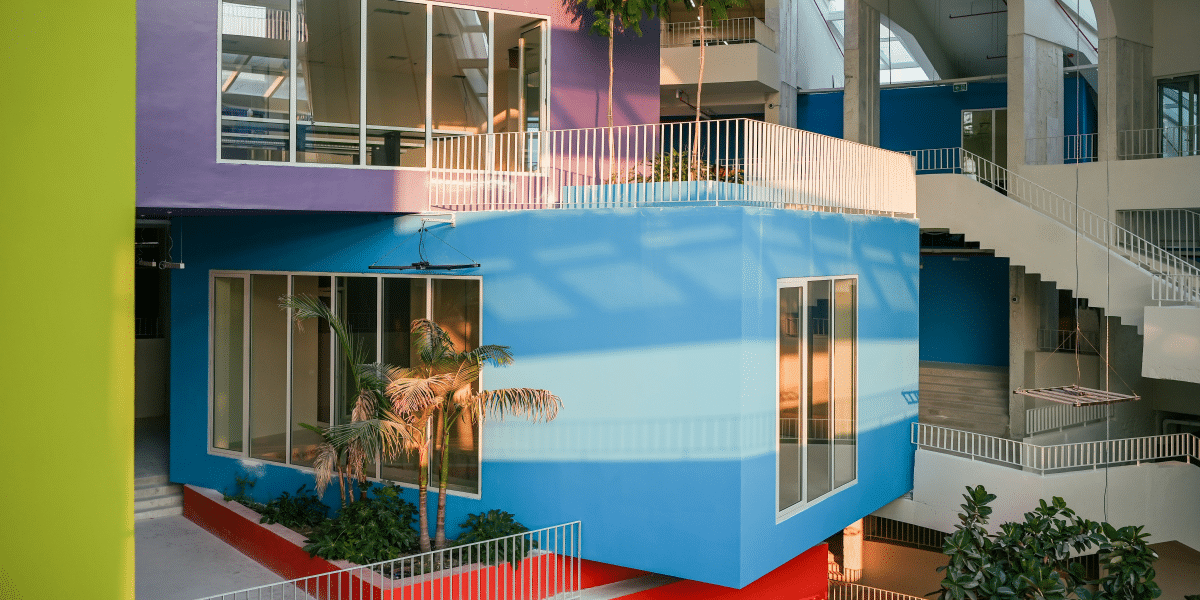By: John Glover (MBA)
What is Playfulness in Architecture?
Playfulness in architecture is about infusing fun and creativity into building design. It’s not just about aesthetics; it’s about creating spaces that engage and inspire. Imagine walking into a building where the design invites you to explore, interact, and even smile. This approach can transform dull, static environments into dynamic and lively spaces.
Playful architecture often incorporates unexpected elements like bold colors, unique shapes, and interactive features. These elements encourage curiosity and engagement, making the space feel more welcoming and enjoyable. Think of it as designing with a sense of wonder, aiming to spark joy and creativity in everyone who uses the space. By prioritizing playfulness, architects can create environments that not only serve functional needs but also enhance the overall user experience, fostering a sense of community and connection.
How Does Playfulness Enhance Creativity and Innovation?
Playfulness in architecture isn’t just about making things look fun; it’s about injecting creativity and innovation into the design process. When architects embrace a playful mindset, they allow themselves to explore unconventional ideas and take risks they might otherwise avoid. This leads to unique and imaginative architectural forms that stand out and engage users in ways traditional designs may not.
For instance, playful design encourages experimentation with shapes, materials, and layouts. This experimentation can result in unexpected solutions to common problems, such as creating multifunctional spaces that adapt to various needs. Think about buildings with slides instead of stairs or public spaces that double as playgrounds. These playful elements not only make the environment more enjoyable but also push the boundaries of what’s possible in architecture.
Moreover, incorporating playfulness can stimulate collaboration among architects, designers, and even the community. When everyone involved feels free to express their creativity without fear of making mistakes, the result is a more dynamic and innovative design process. This collaborative spirit often leads to groundbreaking ideas that redefine how we interact with our built environment.
In essence, playfulness acts as a catalyst for creativity and innovation, transforming architectural design into a more engaging and forward-thinking practice.
What Are the Benefits of Playful Elements in Architectural Design?
Integrating playful elements in architectural design brings numerous benefits that can transform how we experience spaces. First, playfulness encourages creativity and innovation. When architects think outside the box and incorporate playful designs, they often come up with unique solutions that break away from traditional norms. This can lead to more dynamic and visually interesting buildings.
Moreover, playful architecture can significantly enhance user engagement. Spaces that incorporate playful elements, like interactive installations or whimsical features, invite people to explore and interact with their environment. This interaction not only makes the space more enjoyable but also creates a memorable experience for the users.
Another crucial benefit is the promotion of social interaction. Playful elements in public spaces, such as parks or plazas, encourage people to come together, fostering a sense of community. For example, a playground designed with imaginative features can become a gathering spot for families, helping to build stronger community ties.
Additionally, playful architecture can improve well-being. Environments that incorporate elements of fun and play can reduce stress and promote a sense of joy. Whether it’s a splash of color, an unexpected shape, or an interactive element, playful design can make everyday spaces feel more inviting and uplifting.
How Does Playful Architecture Improve User Engagement?
Playful architecture has a unique way of drawing people in and making them want to interact with their surroundings. When spaces are designed with playful elements, they invite exploration and curiosity. This kind of environment naturally encourages users to engage more deeply with the space.
One key aspect is the use of interactive features. Think of installations that respond to touch or movement, like musical stairs or light-up pathways. These elements make the experience of being in the space more dynamic and memorable. People are more likely to return to and spend time in places where they can interact with their environment.
Another important factor is the sense of surprise and delight that playful design can bring. Unexpected features, such as hidden nooks or whimsical sculptures, can make a space feel more inviting and enjoyable. This not only enhances individual experiences but also fosters social interaction. When people are having fun and are intrigued by their surroundings, they’re more likely to engage with others around them.
By creating environments that are both engaging and enjoyable, playful architecture transforms the way spaces are used and perceived. This approach can significantly boost user engagement, making public and private spaces more vibrant and community-focused.
How Can Playfulness Foster Community Interaction?
Playfulness in architecture can significantly boost community interaction. When you incorporate playful elements into public spaces, it naturally invites people to engage with their surroundings and with each other. Think about public parks with interactive sculptures or playgrounds designed not just for kids but for adults too. These spaces become communal gathering points where people of all ages and backgrounds can connect.
Moreover, playful design can break down social barriers. A well-placed swing or a creatively designed seating area encourages spontaneous conversations and interactions. In Israel, you see this in places like Tel Aviv’s Habima Square, where the playful water fountains and unique seating arrangements draw people together.
By making spaces fun and engaging, you foster a sense of community. People are more likely to spend time in these areas, leading to stronger neighborhood bonds and a more vibrant social atmosphere.
The Impact of Playfulness on Architecture
Incorporating playfulness into architectural design can transform spaces, making them more engaging, innovative, and community-focused. By embracing playful elements, architects can enhance creativity, improve user experience, and foster stronger social interactions, ultimately leading to more vibrant and inclusive environments.
Published by: Khy Talara

















